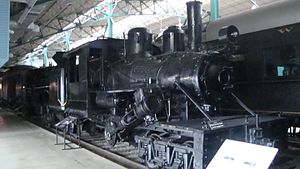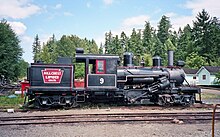
A steam locomotive is a locomotive that provides the force to move itself and other vehicles by means of the expansion of steam. It is fuelled by burning combustible material to heat water in the locomotive's boiler to the point where it becomes gaseous and its volume increases 1,700 times. Functionally, it is a steam engine on wheels.

Mason Bogie locomotives are a type of articulated tank locomotive suited for sharp curves and uneven track, once commonly used on narrow-gauge railways in the United States. The design is a development of the Single Fairlie locomotive.

A geared steam locomotive is a type of steam locomotive which uses gearing, usually reduction gearing, in the drivetrain, as opposed to the common directly driven design.

The Shay locomotive is a geared steam locomotive that originated and was primarily used in North America. The locomotives were built to the patents of Ephraim Shay, who has been credited with the popularization of the concept of a geared steam locomotive. Although the design of Ephraim Shay's early locomotives differed from later ones, there is a clear line of development that joins all Shays. Shay locomotives were especially suited to logging, mining and industrial operations and could operate successfully on steep or poor quality track.

The Heisler locomotive is one of the three major types of geared steam locomotives and the last to be patented.

The Willamette locomotive was a geared steam locomotive of the Shay locomotive type, built by the Willamette Iron and Steel Works of Portland, Oregon. After key patents on the Shay locomotive had expired, it was possible for other manufacturers to produce Shay-like locomotive designs.

A Mallet locomotive is a type of compound articulated steam locomotive, invented by the Swiss engineer Anatole Mallet (1837–1919).

Under the Whyte notation for the classification of steam locomotives, 4-8-4 represents the wheel arrangement of four leading wheels on two axles, eight powered and coupled driving wheels on four axles and four trailing wheels on two axles. The type was first used by the Northern Pacific Railway, and initially named the Northern Pacific, but railfans and railroad employees have shortened the name since its introduction. It is most-commonly known as a Northern.

A locomotive booster for steam locomotives is a small supplementary two-cylinder steam engine back-gear-connected to the trailing truck axle on the locomotive or one of the trucks on the tender. It was invented in 1918 by Howard L. Ingersoll, assistant to the president of the New York Central Railroad.

A drive shaft, driveshaft, driving shaft, tailshaft, propeller shaft, or Cardan shaft is a component for transmitting mechanical power and torque and rotation, usually used to connect other components of a drivetrain that cannot be connected directly because of distance or the need to allow for relative movement between them.
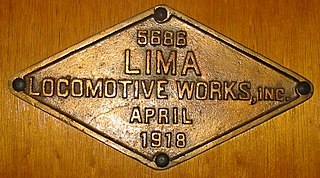
Lima Locomotive Works was an American firm that manufactured railroad locomotives from the 1870s through the 1950s. The company took the most distinctive part of its name from its main shop's location in Lima, Ohio. The shops were located between the Erie Railroad main line, the Baltimore & Ohio's Cincinnati-Toledo main line and the Nickel Plate Road main line and shops.

Under the Whyte notation for the classification of steam locomotives, 4-2-0 represents the wheel arrangement of four leading wheels on two axles, two powered driving wheels on one axle and no trailing wheels. This type of locomotive is often called a Jervis type, the name of the original designer.

An articulated locomotive is a steam locomotive with one or more engine units that can move independently of the main frame. Articulation allows the operation of locomotives that would otherwise be too large to negotiate a railroad's curves, whether mainlines or special lines with extreme curvature such as logging, industrial, or mountain railways.

Cass Scenic Railroad State Park is a state park and heritage railroad located in Cass, Pocahontas County, West Virginia.

A jackshaft is an intermediate shaft used to transfer power from a powered shaft such as the output shaft of an engine or motor to driven shafts such as the drive axles of a locomotive. As applied to railroad locomotives in the 19th and 20th centuries, jackshafts were typically in line with the drive axles of locomotives and connected to them by side rods. In general, each drive axle on a locomotive is free to move about one inch (2.5 cm) vertically relative to the frame, with the locomotive weight carried on springs. This means that if the engine, motor or transmission is rigidly attached to the locomotive frame, it cannot be rigidly connected to the axle. This problem can be solved by mounting the jackshaft on unsprung bearings and using side-rods or chain drives.

The South African Railways Class 21 2-10-4 of 1937 was a class of steam locomotives used in South Africa.
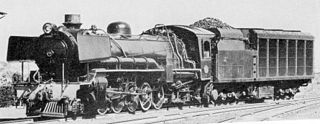
The South African Railways Class 20 2-10-2 of 1935 was a steam locomotive.

A steam motor is a form of steam engine used for light locomotives and light self-propelled motor cars used on railways. The origins of steam motor cars for railways go back to at least the 1850s, if not earlier, as experimental economizations for railways or railroads with marginal budgets. These first examples, at least in North America, appear to have been fitted with light reciprocating engines, and either direct or geared drives, or geared-endless chain drives. Most incorporated a passenger carrying coach attached to the engine and its boiler. Boiler types varied in these earlier examples, with vertical boilers dominant in the first decade and then with very small diameter horizontal boilers. Other examples of steam motor cars incorporated an express-baggage or luggage type car body, with coupling apparatus provided to allow the steam motor car to draw a light passenger coach.

LNER Class P2 No. 2007 Prince of Wales is a 2-8-2 "Mikado" steam locomotive being built at Darlington Locomotive Works, England, and managed by the A1 Steam Locomotive Trust. It will be the seventh member of its class and the only P2 in existence; the original six were built between 1934 and 1936 for the London and North Eastern Railway (LNER) to a design by Nigel Gresley, and employed to haul heavy passenger trains on the Edinburgh to Aberdeen line. The P2s were declared Britain's most powerful express passenger engines, although none were preserved.
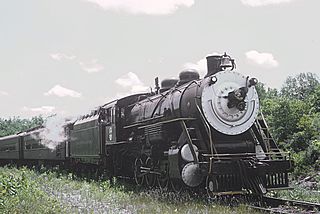
Buffalo Creek and Gauley Railroad No. 4 is a preserved 2-8-0 "Consolidation" type steam locomotive. It was constructed by Baldwin in 1926 as the only locomotive to be bought-new by the Buffalo Creek and Gauley Railroad. It served the railroad by pulling coal and lumber trains throughout Clay County, West Virginia until it was retired in 1965. No. 4 was restored to operating condition by the Quakertown and Eastern Railroad for excursion service in Pennsylvania, and it made its way to the North Carolina Transportation Museum in 1978. No. 4 was subsequently used to pull tourist trains across the museum's property in Spencer, North Carolina from when its multi-year overhaul was completed in 1986 to when its flue time expired in 2001. The locomotive spent fourteen years in storage, waiting for a rebuild that never came to fruition. In 2015, No. 4 was purchased by the Durbin and Greenbrier Valley Railroad, who moved it to their shops with the hopes of restoring it to run it on their trackage between Durbin and Cass, West Virginia.
